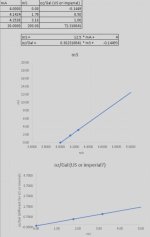Hi Guys
I need a bit of help here with my math!
I have to measure the conductivity of caustic in a line. Now what I have been given by the supplier of the fluid is that we need a conductivity target range of 1oz/gal 3.16 mS. However the conductivity meter that has been installed gives an output of 0…999 mS/cm (as a 4-20mA signal).
Now according to Google 1 fluid oz/gallon (US) = 7.8125 × 10^-5 meters / centimetre (0.000078125 mS).
But surely converted this means that we are looking for 0.000078125 * 3.16 = 0.000246875 mS/cm (well outside the range of the meter) and too small to detect.
I am obviously doing something seriously wrong with my math here.
Can anybody point to my basic error?
Thanks
I need a bit of help here with my math!
I have to measure the conductivity of caustic in a line. Now what I have been given by the supplier of the fluid is that we need a conductivity target range of 1oz/gal 3.16 mS. However the conductivity meter that has been installed gives an output of 0…999 mS/cm (as a 4-20mA signal).
Now according to Google 1 fluid oz/gallon (US) = 7.8125 × 10^-5 meters / centimetre (0.000078125 mS).
But surely converted this means that we are looking for 0.000078125 * 3.16 = 0.000246875 mS/cm (well outside the range of the meter) and too small to detect.
I am obviously doing something seriously wrong with my math here.
Can anybody point to my basic error?
Thanks






